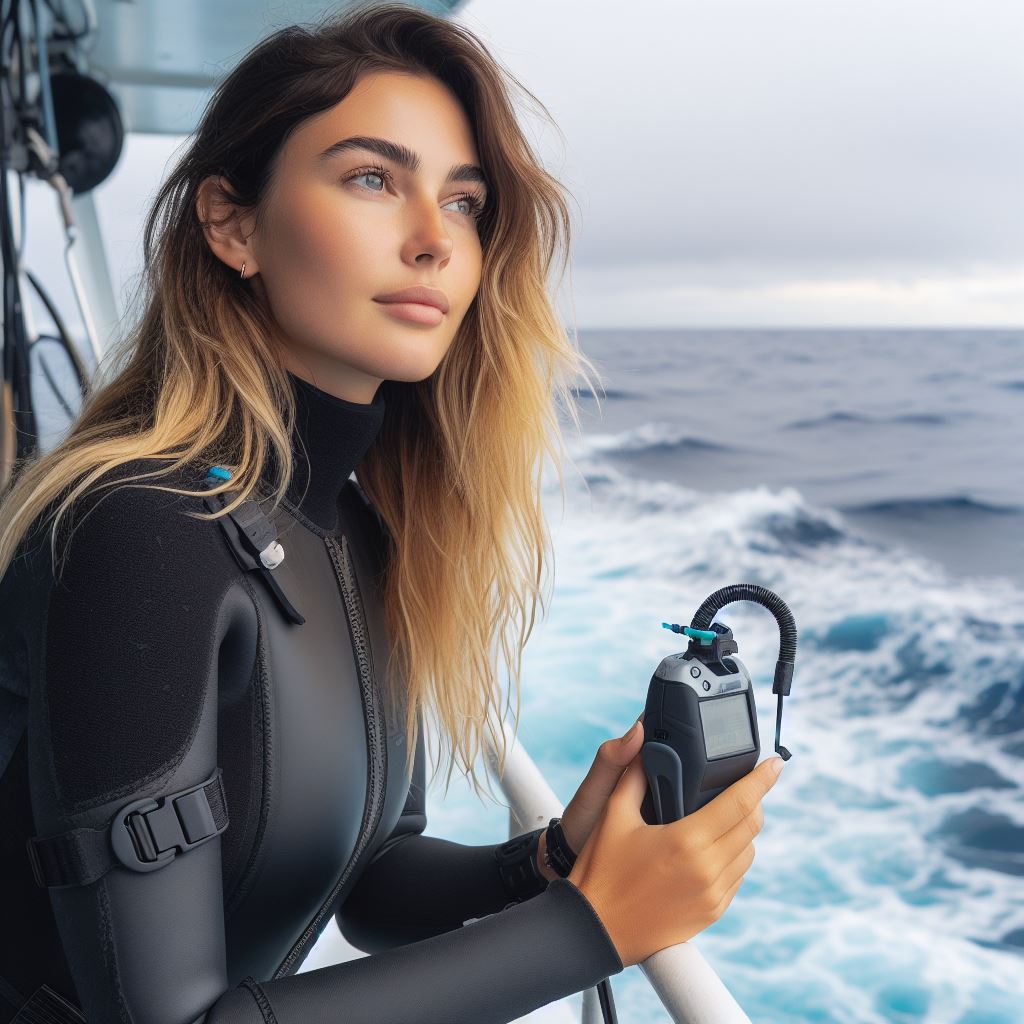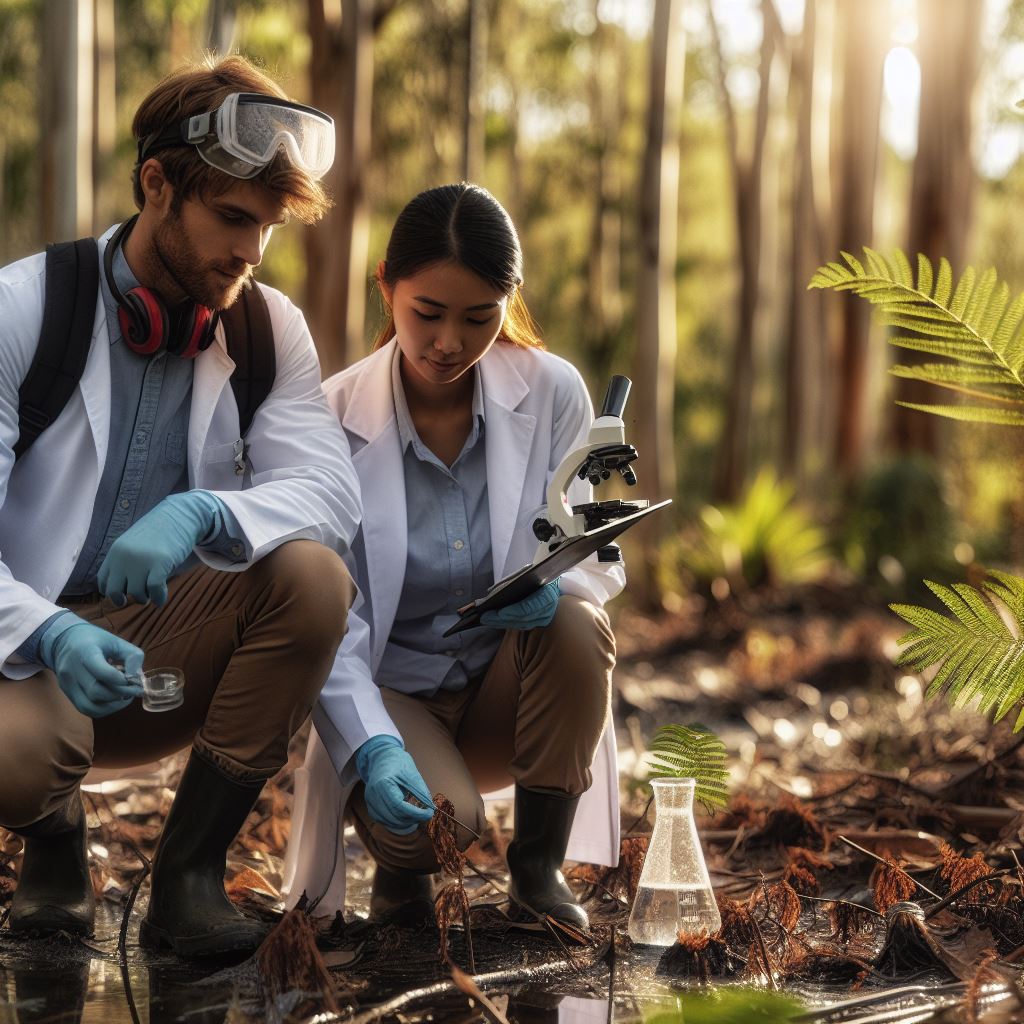Introduction
Marine biology as a scientific field
Marine biology is a scientific field that explores the organisms and ecosystems of the ocean. It relies heavily on technology and innovations for research and study.
Technology plays a crucial role in marine biology, enabling scientists to obtain and analyze data with greater precision. Innovations in underwater robots have allowed for remote exploration of the deep sea, unveiling hidden ecosystems and species.
Satellite imagery is another technological advancement that offers valuable insights into ocean currents, temperature patterns, and the distribution of marine life.
This information helps scientists understand the impacts of climate change on marine organisms and ecosystems.
DNA sequencing technology has revolutionized the field, making it easier to identify and study marine species.
By analyzing DNA samples, researchers can determine genetic diversity, understand evolutionary relationships, and track the movement of marine species.
Importance of technology and innovations in marine biology research and study
In addition to technology, innovations have led to the development of new research techniques and tools. For example, the use of acoustic technology has allowed scientists to study the sounds made by marine animals, providing insights into their behavior and communication.
Advancements in underwater cameras and imaging technology have also allowed for more detailed observations of marine organisms and their habitats. This helps researchers study their behavior, reproductive cycles, and interactions with the environment.
Overall, technology and innovations have revolutionized marine biology, enabling scientists to explore and study the ocean in ways that were once unimaginable.
These tools and techniques are essential for understanding and conserving the complex and fragile ecosystems that make up our oceans.
Technological Advancements
Technological strides in marine biology benefit from remotely operated vehicles (ROVs), revolutionizing scientists’ study of marine life, especially in deep-sea environments.
ROVs offer advantages, enabling researchers to access valuable, previously unreachable data.
One major advantage is their ability to reach great depths, enduring extreme pressures and temperatures for exploring dangerous environments.
Researchers, by reaching these depths, gain insights into unexplored marine ecosystems, discovering new species and observing unique adaptations.
The maneuverability of ROVs is another key benefit, navigating the ocean with precision to collect accurate data and samples.
Equipped with high-quality cameras and sensors, ROVs capture detailed images and data, providing rich information for analysis.
Despite advantages, ROVs have limitations, including restricted battery life and limited field of vision, requiring careful planning during research missions.
Operating and maintaining ROVs can be costly, demanding skilled operators and regular maintenance.
ROVs contribute to notable studies, such as discovering a new deep-sea octopus species in the Pacific Ocean.
They unveil mysteries of hydrothermal vents, revealing unique ecosystems thriving in extreme conditions.
ROVs study deep-sea species, providing valuable insights into their biology and ecology.
Crucial roles include studying coral reefs, assessing their health, and understanding pollution and climate change impacts.
In Antarctica, ROVs contribute to understanding marine biodiversity and effects of glacial melt on ecosystems.
Key tools during deep-sea oil spills, ROVs investigate ecological consequences and evaluate damage extent.
Collecting DNA and biological materials, ROVs facilitate genetic studies, advancing marine organisms understanding.
ROVs, indispensable in marine biology, explore uncharted territories, revealing new species and enhancing marine ecosystems understanding.
Despite limitations, ROVs’ benefits far outweigh challenges, continually pushing marine biology boundaries, opening new exploration and discovery avenues.
Use of Drones in Marine Biology
Application of drones in collecting data and monitoring marine environments
- Drones equipped with cameras and sensors can capture high-resolution images and videos of marine ecosystems.
- These images can provide valuable information about coral reefs, seagrass beds, and other habitats.
- Drones can also collect samples of water, sediment, and marine organisms for further analysis.
- They can cover large areas of the ocean quickly and efficiently, providing researchers with a comprehensive view of the environment.
Advantages of using drones in research
- Drones can access remote and difficult-to-reach areas, such as deep-sea trenches and polar regions.
- This allows scientists to study previously inaccessible marine habitats and species.
- Drones are cost-effective compared to traditional research methods, such as manned submersibles or research vessels.
- They require less manpower and can be deployed for longer periods, increasing data collection capabilities.
- Drones provide real-time data, allowing researchers to make immediate decisions and adapt their study plans.
- They reduce potential disturbances to marine life compared to divers or boats, minimizing the impact on the environment.
Case studies showcasing the effectiveness of drones in marine biology
- A study conducted in the Great Barrier Reef used drones to monitor coral bleaching events.
- The drones captured high-resolution images, providing a detailed assessment of the affected areas.
- Researchers were able to identify specific locations for targeted conservation efforts.
- In another study, drones were used to track humpback whales in their feeding grounds.
- The drones provided accurate information about whale behavior, population size, and distribution patterns.
- This data helped authorities implement better conservation measures for protecting these migratory species.
Therefore, the use of drones in marine biology has revolutionized data collection and monitoring efforts.
They offer numerous advantages, including their ability to access remote areas, cost-effectiveness, and real-time data transmission.
Case studies have demonstrated their effectiveness in studying coral reefs, marine habitats, and species distribution.
As technology continues to advance, drones will play an increasingly vital role in understanding and conserving marine ecosystems.
Read: Postgrad Paths in AU Research
Underwater Acoustic Technologies
Underwater acoustic technologies collect vital data, aiding marine biology research profoundly.
Scientists study behavior and migration patterns using these technologies.
Acoustic tags track marine animals, revealing movements and habitat preferences.
Tags emit signals detectable by underwater receivers.
Researchers analyze signals to determine animals’ location, depth, and interactions.
Understanding marine animals is crucial for conservation efforts.
Challenges in implementing underwater acoustic technologies include noise interference.
External noise distorts acoustic signals emitted by animals.
Scientists develop signal processing techniques to filter unwanted noise.
Specialized tags emit distinguishable signals, overcoming interference issues.
Limited range of acoustic transmissions underwater presents challenges.
Sound waves propagate differently in water, reducing transmission distances.
Scientists continuously improve efficiency and range of acoustic technologies.
Recent advancements include directional systems focusing sound waves accurately.
These systems enable accurate and long-range data collection.
Acoustic technologies also study habitats, not just tracking animals.
Passive monitoring analyzes underwater ecosystems’ soundscape.
Identifying sounds provides insights into biodiversity and habitat health.
Vocalizations indicate species presence or reproductive behavior.
Underwater acoustic technologies emerge as powerful tools in research.
They offer non-invasive means of studying marine life.
Advancing technology will enhance understanding of marine ecosystems.
Underwater acoustic technologies undoubtedly contribute more to understanding ecosystems.
Read: Tech in Research: AU’s Leading Edge
Find Out More: Day in the Life of a Chemist in Australia
Your Personalized Career Strategy
Unlock your potential with tailored career consulting. Get clear, actionable steps designed for your success. Start now!
Get StartedDNA Sequencing and Conservation
In marine biology research, DNA sequencing techniques play a crucial role in understanding the genetic makeup of organisms, aiding in conservation efforts.
Overview of DNA Sequencing Techniques Used in Marine Biology Research
- Sanger sequencing, a traditional method, is used to determine the sequence of DNA fragments.
- Next-generation sequencing (NGS) technologies enable massive parallel sequencing, making it faster and more cost-effective.
- Metagenomic sequencing allows the study of genetic material from entire communities, capturing the biodiversity of marine ecosystems.
- Environmental DNA (eDNA) sequencing detects traces of genetic material shed by organisms, providing valuable information about their presence.
Importance of Genetic Analysis in Conservation Efforts
Genetic analysis through DNA sequencing plays a crucial role in marine conservation efforts
- Understanding population structure and connectivity helps identify key areas for protection and enhance management strategies.
- Assessing species diversity and genetic diversity informs conservation planning and prioritization.
- Identifying and classifying species accurately aids in the conservation of endangered or threatened marine organisms.
- Tracking invasive species using genetic analysis helps prevent their spread and mitigate their impacts on native ecosystems.
Successful Conservation Stories Using DNA Sequencing
DNA sequencing has contributed to several successful marine conservation initiatives:
- Identification of Coral species: DNA barcoding allowed distinguishing endangered coral species from similar-looking ones, aiding preservation efforts.
- Uncovering Illegal Trade: DNA analysis exposed the illegal trade of seahorses, guiding stricter regulations to protect these vulnerable species.
- Preserving Monk Seals: Genetic analysis helped identify population structure and migration patterns, leading to targeted conservation strategies for monk seals.
- Protecting Marine Turtles: DNA sequencing revealed nesting sites and migration routes, essential for establishing marine protected areas for these endangered species.
In fact, DNA sequencing techniques have revolutionized marine biology research and conservation efforts:
- These techniques provide valuable insights into the genetic makeup of marine organisms.
- Genetic analysis helps in understanding population dynamics, assessing biodiversity, and tracking invasive species.
- Successful conservation stories demonstrate how DNA sequencing has directly contributed to preserving marine ecosystems and their inhabitants.
As technology advances, DNA sequencing will continue to play an increasingly vital role in marine biology and conservation, guiding future efforts to protect and sustain our oceans.
Read: Innovative Chemistry Startups in Australia

You Might Also Like: Top Aussie Science Fields for Researchers
Future Directions and Innovations
Marine biology research has witnessed significant advancements in recent years, thanks to emerging technologies. These technologies have revolutionized the way scientists study and understand marine ecosystems.
In this section, we will explore some of the future directions and innovations in marine biology tech that hold immense potential.
Emerging technologies in marine biology research
Advancements in technology have allowed scientists to explore the depths of the oceans like never before. Remote-operated vehicles (ROVs) and autonomous underwater vehicles (AUVs) have become essential tools for marine biologists.
These devices can collect data, capture images, and even retrieve specimens from deep-sea environments.
Furthermore, the use of high-resolution imaging systems has revolutionized our understanding of marine life. Techniques like 3D imaging and photogrammetry enable researchers to create detailed models of organisms and their habitats.
This provides valuable insights into their behavior, population dynamics, and ecological interactions.
Potential advancements in understanding and preserving marine ecosystems
Marine biology tech has immense potential in advancing our understanding of marine ecosystems. For instance, genetic sequencing techniques have revolutionized our ability to identify and classify species.
By sequencing DNA from environmental samples, scientists can discover new and previously unknown organisms.
Additionally, advances in acoustic technologies have allowed researchers to study marine life using sound. Passive acoustic monitoring systems can detect and track the movements of marine animals, providing valuable information on their behavior and distribution.
This technology can also help monitor the impacts of human activities on marine ecosystems, such as underwater noise pollution.
Furthermore, the development of eco-friendly marine technologies can help preserve fragile marine ecosystems. For example, alternative energy sources like wave and tidal power can reduce our reliance on fossil fuels, minimizing the negative impacts on marine life.
Additionally, the use of biodegradable materials in marine equipment can help reduce pollution and protect marine organisms.
Ethical considerations and challenges associated with marine biology tech developments
While marine biology tech advancements offer immense opportunities, they also raise ethical considerations and challenges. One of the main concerns is the potential disturbance to marine life caused by the use of advanced technologies.
For example, ROVs and AUVs, although invaluable for research purposes, can cause stress and disruption to marine organisms if not operated responsibly.
Stand Out with a Resume That Gets Results
Your career is worth more than a generic template. Let us craft a resume and cover letter that showcase your unique strengths and help you secure that dream job.
Get HiredAnother ethical concern is the potential for overexploitation of marine resources. Advanced fishing technologies, such as fish aggregating devices and deep-sea trawling equipment, can have detrimental impacts on fish populations and their habitats.
Therefore, it is crucial to ensure that the use of such technologies is regulated and sustainable.
Furthermore, data privacy and sharing present additional ethical challenges in marine biology research. With the increasing use of interconnected devices and sensors, ensuring the security and responsible use of data becomes crucial.
Guidelines must be established to protect the privacy and intellectual property of researchers and the traditional knowledge of indigenous communities.
Ultimately, the future of marine biology research is closely intertwined with technological innovations. Emerging technologies hold great promise in advancing our understanding of marine ecosystems and preserving their biodiversity.
However, it is essential to address the ethical considerations and challenges associated with these advancements to ensure sustainable and responsible use of marine biology tech.
Read: The Future of Green Chemistry in Australia
See Related Content: Key Skills Needed in Marine Biology
Discover More: Day in a Life of Aussie Research Pros
Explore Further: Chemistry Job Market Outlook in Australia
Conclusion
Recap of the importance of technology and innovation in marine biology
Technology and innovation play a crucial role in marine biology, revolutionizing research and conservation efforts.
The advancement of techniques such as DNA analysis, underwater robotics, and satellite imagery has greatly enhanced our understanding of the marine ecosystem.
These technologies allow scientists to study previously inaccessible areas and collect data more efficiently, leading to better-informed conservation strategies.
Additionally, innovations like aquatic drones and unmanned underwater vehicles have revolutionized data collection, providing real-time information on marine organisms and their habitats.
Final thoughts on the potential impact of future advancements on marine conservation and understanding
The potential impact of future advancements in marine biology technology is immense. As technology continues to progress, we can expect even more sophisticated tools and techniques to be developed.
This will enable scientists to delve deeper into the mysteries of the ocean, uncovering new and exciting discoveries.
Moreover, the integration of big data analysis and artificial intelligence has the potential to revolutionize marine conservation efforts.
By analyzing vast amounts of data, researchers can identify patterns, predict ecosystem changes, and develop strategies to mitigate human impacts on marine environments.
In summary, technology and innovation are essential for the progress of marine biology. They not only help us better understand and conserve marine life but also hold the key to unlocking untapped potential in the field.
With continued advancements, we can expect exciting breakthroughs that will contribute to the protection and sustainability of our oceans.




